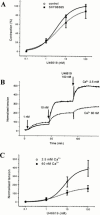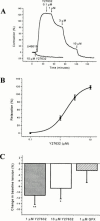Rho-kinase inhibitors prevent agonist-induced vasospasm in human internal mammary artery
- PMID: 11156590
- PMCID: PMC1572553
- DOI: 10.1038/sj.bjp.0703809
Rho-kinase inhibitors prevent agonist-induced vasospasm in human internal mammary artery
Abstract
1. Vasospasm of arterial conduits used for coronary artery surgery is an important cause of graft failure and is likely to result partly from raised levels of vasoconstrictor substances such as thromboxane A(2) and endothelin-1. Our aim was to find pharmacological agents that could prevent agonist-induced vasospasm. 2. Isometric tension was recorded from discarded segments of human left internal mammary artery (LIMA). Submaximal contraction evoked by the thromboxane A(2) mimetic U46619 (10 nM) was not inhibited by a blocker of store- and receptor-operated Ca(2+) channels (30 microM SKF96365) in the presence of diltiazem. Furthermore, contractions to < or =1 nM U46619 were preserved when extracellular Ca(2+) was reduced from 2.5 mM to 60 nM. Thus, sustained U46619-evoked contraction occurred without Ca(2+) influx. 3., We hypothesized that contraction might occur via Rho-kinase-mediated Ca(2+)-sensitization of myofilaments. Inhibitors of Rho-kinase (Y27632 and HA1077) were profound relaxants. If contraction was pre-evoked by 10 nM U46619, Y27632 and HA1077 caused full relaxation with EC(50)s of 1.67+/-0.22 microM and 3.58+/-0.35 microM respectively. Y27632 was also effective if applied before U46619, but was less potent. 4. Y27632 abolished contraction evoked by endothelin-1 and significantly reduced resting tone in the absence of a vasoconstrictor. 5. Rho-kinase-mediated Ca(2+)-sensitization appears to be a major mechanism of vasoconstriction in human LIMA. Rho-kinase inhibitors may have an important role in preventing vasospasm in arterial grafts used for coronary artery surgery.
Figures






References
-
- CABLE D.G., CACCITOLO J.A., PEARSON P.J., O'BRIEN T., MULLANY C.J., DALY R.C., ORSZULAK T.A., SCHAFF H.Z. New approaches to prevention and treatment of radial artery graft vasospasm. Circulation. 1998;98:II-15–II-22. - PubMed
-
- FAYMONVILLE M.E., DEBY-DUPONT G., LARBUISSON R., DEBY S., BODSON L., LIMET R., LAMY M. Prostaglandin E2, prostacyclin, and thromboxane changes during nonpulsatile cardiopulmonary bypass in humans. J. Thorac. Cardiovasc. Surg. 1986;91:858–866. - PubMed
-
- FU X., GONG M.C., JIA T., SOMLYO A.V., SOMLYO A.P. The effects of the Rho-kinase inhibitor Y-27632 on arachidonic acid-, GTPγS-, and phorbol ester-induced Ca2+ sensitization of smooth muscle. FEBS Lett. 1998;440:183–187. - PubMed
Publication types
MeSH terms
Substances
LinkOut - more resources
Full Text Sources
Miscellaneous

